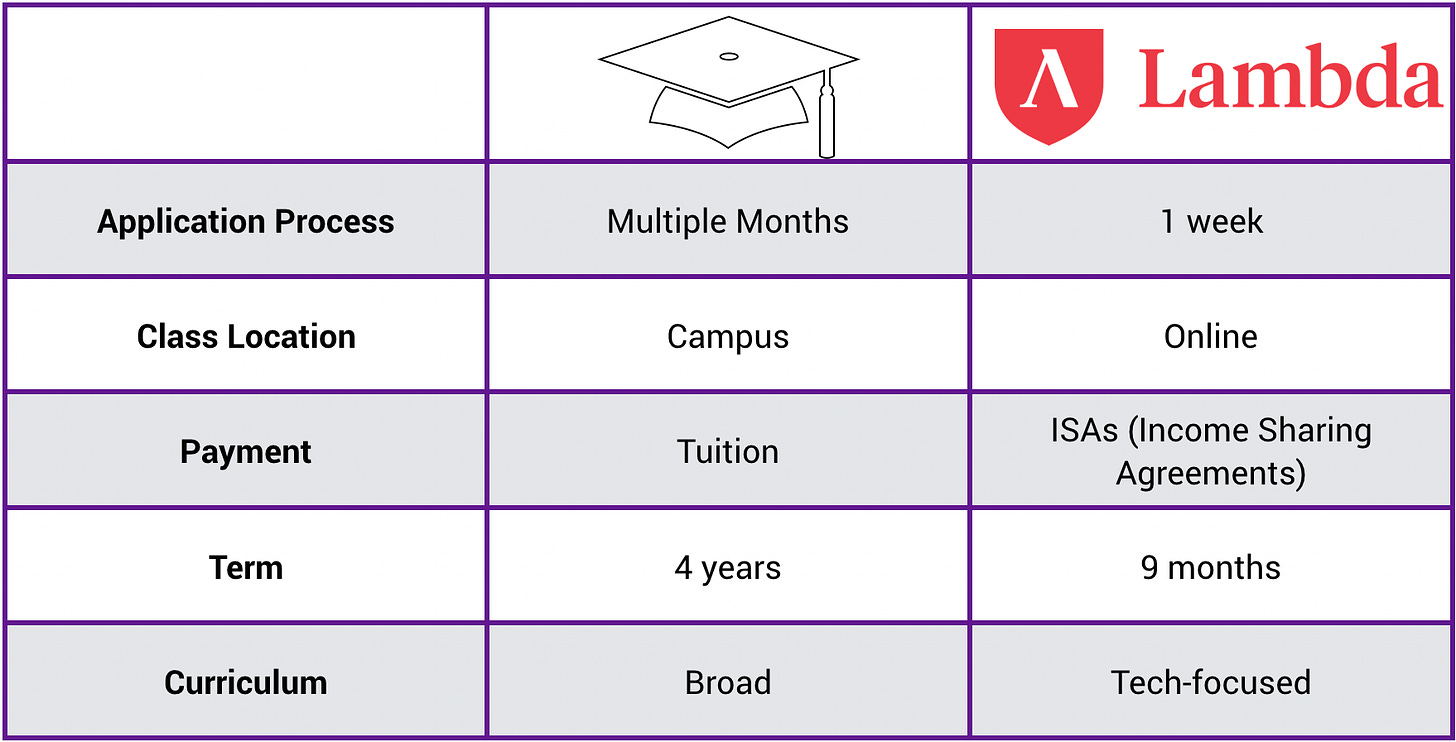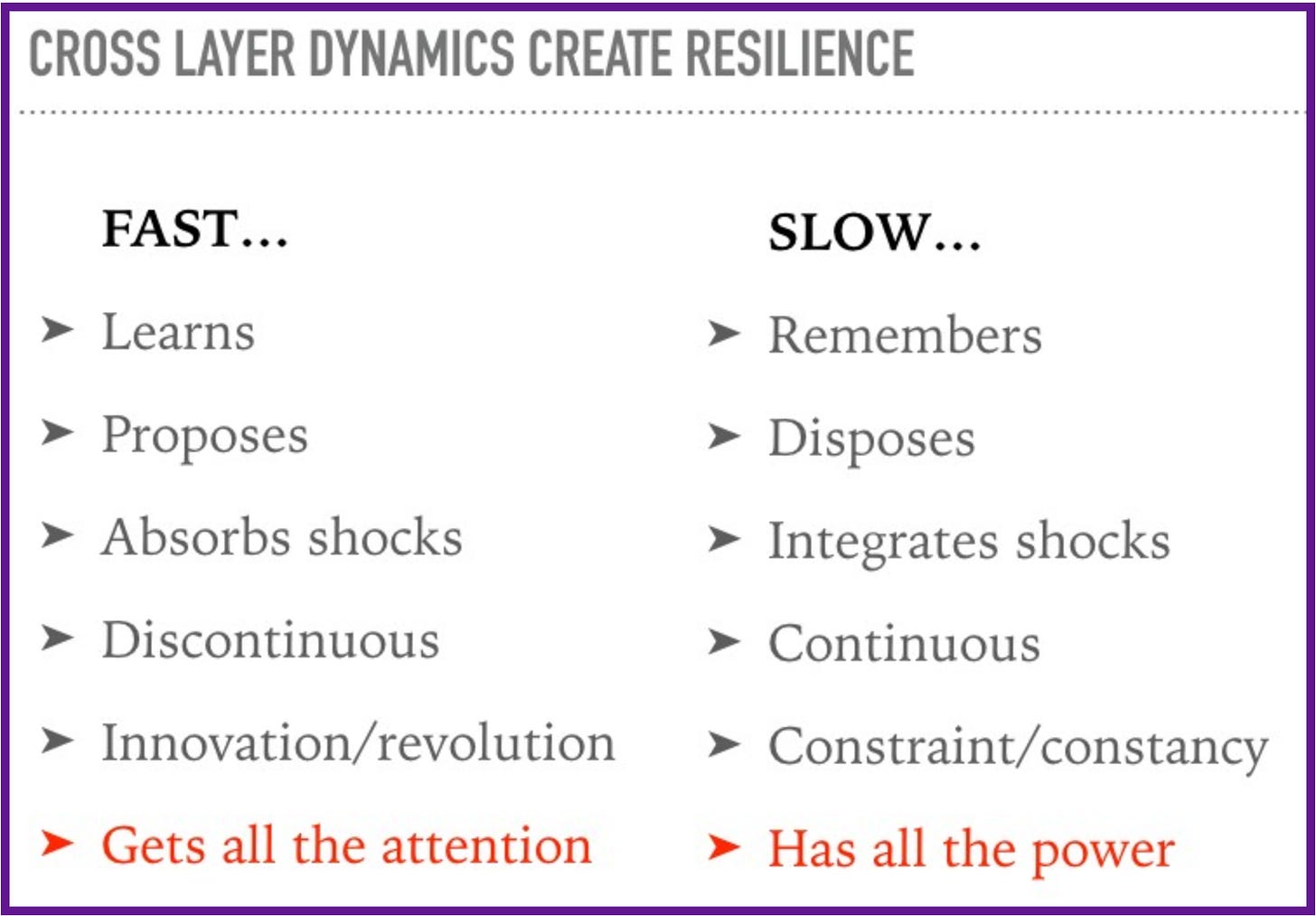Higher Education is a hot button topic.
Student debt has been one of the biggest issues in politics for the last decade, and there’s no end in sight.
While the sheer volume of online courses and alternative approaches to learning have exploded, one company has made it its mission to challenge the payment model of traditional higher education.
Today, I want to talk about the pricing and product of Lambda School.
SaaS Pricing is hard. PricingSaaS is your cheat code.
Monitor competitors, track real-time benchmarks, discover new strategies, and more.
Lambda School’s Un-Incumbent Positioning
For those that haven’t heard of Lambda School, the simplest way to describe the company is an online coding Bootcamp that helps students transition to a career in technology. However, that description wouldn’t be doing them justice. Lambda School’s mission is to reinvent access to higher education.
Un-Incumbent is a term I’ve been kicking around to describe companies that take an adversarial role to the status quo of their respective industry. The term is adapted from T-Mobile’s Un-Carrier campaign that positioned them against the wireless duopoly of Verizon and ATT by introducing innovative wireless plan updates - many of which have since been widely adopted.
Un-incumbents are a hyper-aggressive breed of disrupters that aim to rattle an industry and energize their company around a theme of reinvention.
Lambda School fits nicely into this category. The only thing they have in common with traditional academic institutions is the intention to educate. Here are some of the differences at a glance:
Looking at the table above, every comparison positions Lambda School as the faster-paced alternative to traditional higher education:
You can apply in less than an hour and hear back in 4-5 days.
The classes are online and accessible from anywhere.
Payment happens after you graduate and only if you land a tech-sector job making at least $50k per year (Graduates pay 17% of their salary for two years or up to $30k)
The courses take 9 months and are hyper-focused, honing in on programming and design.
Speed is clearly important to Lambda School’s mission, both to help graduates move into the tech sector rapidly and to differentiate from the glacial pace at which traditional higher education moves. Speed is also essential to the company’s growth. The more students they admit, the more jobs they can place, and the more they can earn from Income Sharing Agreements.
This focus on speed brings to mind an axiom from the early days of Facebook: Move Fast and Break Things. While Facebook has distanced themselves from their early motto, the mentality remains pervasive across many tech startups.
The rest of this case study explores the impact of this mindset on Lambda School’s pricing and product, and why their recent challenges and negative headlines are an inevitable byproduct of their brand of disruption.
Pricing: The Power of Skin in the Game
In his book, Skin in the Game, Nassim Taleb introduces the Bob Rubin trade. Bob Rubin was CEO of Citibank prior to the financial crisis and made $120M in the years leading up to it. When the crisis struck, and Citibank had to be bailed out by the American taxpayer, Rubin did not have to give a penny of that $120M back.
Taleb argues that it’s this lack of skin in the game that allows crises like 2008 to happen. Perhaps if Rubin knew he would have to pay back the money he lost Citibank clients, he would have encouraged his team to be more discerning with their investments.
To a certain extent, most companies believe they have skin in the game. If you are not driving value for customers, customers will leave, and your business will collapse. That said, it’s rare that an organization actually puts their money where their mouth is, and perfectly aligns pricing with customer success.
It can be argued that the current student debt crisis has arisen because it’s missing an element of skin in the game. Colleges collect tuition regardless of whether or not a student finds a job after graduation, hence the typical sequence of events at an American university:
The reshuffling of this order is the most important differentiator between Lambda School and traditional higher education. While colleges are paid through a tuition model, Lambda School charges students via post-grad Income Sharing Agreements if, and only if, they find a tech-sector job making over $50k per year. Here’s the updated order as it relates to Lambda School:
The important takeaway here is if a student doesn’t find a job in tech, Lambda School doesn’t get paid. This ensures their business model is aligned with student outcomes. On its face, this model is inherently virtuous and presents the fundamental underpinning of the Lambda School mission statement. In a blog post outlining why he started the company, CEO Austin Allred writes:
"I thoroughly believe that the only way the country will be able to move forward and train this and future generations is by not only reducing the cost of higher education, but by eliminating the risk of higher education. We need to replace the current model of education with something that doesn’t leave people broke for the rest of their lives if it doesn’t work out."
This is a seriously inspirational mission statement and a great example of disruption used for good. This brings us to Lambda School’s product, specifically their faculty and curriculum, which also embody their disruptive approach.
Product: The Tech-Startup/Faculty Hybrid
When I think of the Dean of a traditional university, I imagine an austere man or woman, likely in their fifties or sixties, tucked away in an office lined with shelves of leather-backed books. This person has degrees on the wall, dresses formally and gives off an air of intellectual authority. That is not how I would describe Lambda School CEO, Austin Allred.
First, Allred is young. At thirty, he’s a serial-entrepreneur, and notably, has over 100,000 followers on Twitter, where he's a one-man hype train for Lambda School. While most deans could learn a lot from Allred about self-promotion, his Twitter activity marks an important difference between Lambda School and traditional universities. Specifically, Lambda School is a tech company, and Allred is a tech CEO.
This distinction permeates Lambda School’s product, including its faculty and curriculum. In his mission statement blog post, note the order in which Allred cites where Lambda School professors come from:
"We’ve found that we can and will do whatever it takes to ensure that people get high-paying jobs. That includes expensive instructors (from Google, NASA, and MIT).”
Only one of the three is a traditional university, MIT, and it’s mentioned last. This itself isn’t a bad thing - Lambda School’s Un-Incumbent positioning makes it fundamentally opposed to traditional colleges, so it’s surprising he referenced one at all.
Nassim Taleb, for one, supports the fundamental premise that college professors may not be the best people to learn trade-skills from. Back to Skin in the Game:
"By some mysterious mental mechanism, people fail to realize that the principal thing you can learn from a professor is how to be a professor."
This is oversimplified, as many professors shift to teaching after years of professional experience, but the argument has some merit. What aspiring engineer wouldn’t want to learn from engineers that worked at Google and NASA? The problem is that this tech-centric approach to faculty trickles further down.
The biggest example is Lambda School’s reliance on Team Leads to teach their courses. From a profile of Lambda School in NY Mag:
"Lambda’s educational model hinges on student-contractors called Team Leads (TLs) — students who, two months into their education, defer another two months in order to become teaching assistants tasked with taking attendance, checking in with other students, and answering questions. These student-contractors are paid roughly $13 an hour and have only just learned the material they are then tasked with explaining to the next batch of students."
The Team Lead player/coach hybrid is popular at tech startups where proven individual contributors act as mentors to new hires. For startups, it’s a low-cost approach to pressure-test emerging management candidates. This makes sense given that new hires will get a combination of guidance and on-the-job training.
At Lambda School it’s different. Inexperienced students that have no expertise beyond what they’ve learned in two months at Lambda School are tasked with teaching new students.
Some might say, well, what about Teaching Assistants at traditional colleges? This is fair, but most Teaching Assistants have at least finished and succeeded in the class they’re teaching, and many are graduate students in the field of study.
Additionally, most of the time Teaching Assistants don’t change midway through the semester. According to student accounts, at Lambda School, teachers can change week-to-week, depriving the students of consistency, and inhibiting the teacher from being able to gauge student progress.
Lastly, TA’s support a vetted curriculum - another area where Lambda School differentiates from traditional colleges.
Amid student complaints that the curriculum taught in class rarely matched what was promoted on the Lambda School website, The Verge sent a third party engineering expert undercover to vet the course quality. After review, he says the program doesn’t prepare people to pass even a first-round tech interview. Part of this is likely due to where the course material is sourced. He continues:
“The curriculum itself is indistinguishable from any of the free resources available online,” he added. “It’s all very surface level.”
The combination of a rotating cast of inexperienced teachers conducting classes with ever-changing course material is truly a “blind-leading-the-blind” situation.
It’s hard to look at their course execution without seeing the downside to moving fast and breaking things. While Team Leads and free curriculum save Lambda School money and allow them to teach more students, these advantages come at the expense of course quality, which would ultimately lead to better-prepared graduates and more job placements.
Pace Layers: The Inevitable Tension of Disruption
The recent criticism of Lambda School reminded me of Stuart Brand’s pace layers framework, which synthesizes the tension between innovation and stabilization across different aspects of society.
If you think about these layers as gears, the gears on the outside spin quickly, while the gears on the inside move slowly and act as a stabilizing force. While technology has impacted every layer over the last few decades, the inner layers are most resilient due to the slow pace at which they change.
Higher Education falls in the Infrastructure layer, along with other societal platforms like transportation, communication, and energy. While these fields are all susceptible to disruption, reinvention in the Infrastructure layer is never immediate. In his book, The Clock of the Long Now, Brand highlights how the interaction of fast and slow layers in the course of innovation create resilience:
Through this lens, Lambda School’s recent struggles can be viewed as a natural part of the process of innovation. The negative feedback around course quality is simply the system integrating a shock to Lambda School’s disruptive approach.
If the company can absorb the shock, learn, and innovate by strengthening the quality of their product, then they will likely drive more successful outcomes for students and their company, all while becoming more resilient in the meantime.
Personally, I’m rooting for them. While their recent challenges prove that they’ll need more than an innovative pricing model alone to be successful, if they are, it will open the doors to other alternative educators to copy their model and open up ongoing education to a much wider audience.
Enjoying Good Better Best?
If you enjoyed this post, I’d love it if you hit the “like” button, that way I’ll know which posts are resonating the most!
If you have thoughts or feedback, I’d love to hear it!
Lastly, if you’re enjoying Good Better Best and have friends or colleagues who would enjoy a weekly packaging case study, I’d be thrilled if you shared this with them!








